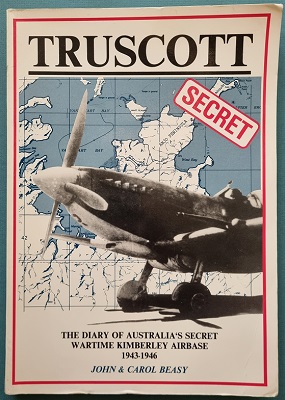Description
Title: Truscott – The Diary of Australia’s Secret Wartime Kimberley Airbase 1943 – 1946
Author: John and Carol Beasy
Condition: Very Good Plus – Has a minor crease on front and rear covers.
Edition: 1st Edition
Publication Date: 1995
ISBN: 0646041045
Cover: Soft Cover without Dust Jacket – 303 pages
Comments: A concise account of the secret RAAF Base (RAAF Truscott) during World War Two.
The airfield was originally constructed in 1944 as a Royal Australian Air Force (RAAF) base and was actively used during World War II. RAAF Truscott was named after the Australian air ace, Keith “Bluey” Truscott, who had been killed in a training accident in 1943.
The World War II base was built to succeed a temporary base 80 km (50 mi) south at Drysdale River Mission (Kalumburu), and was a staging base for Allied bombers and flying boats, from bases further south, making attacks on Japanese targets in the Dutch East Indies. The site was chosen because it is the point on the Australian mainland closest to Java, where Japanese forces were concentrated. Aircraft from nearby RAAF fighter squadrons (and occasionally RAF units) were rotated through the base to provide air defence for the base.
Construction and the subsequent operations from the base were conducted under total secrecy and the existence of the base was never formally acknowledged until after the war.
The host unit at the base was RAAF 58 Operating Base Unit (58OBU). Australian Army anti-aircraft and searchlight batteries were also based at Truscott scattered around the peninsula. A civilian work unit from the Allied Works Council was based at Truscott for the maintenance of roads around the base and a RAAF Marine Section was stationed in West Bay to support the Catalina Flying Boat operations, operate search and rescue water craft and support the maritime resupply of the air base.
RAAF and United States Army Air Forces (USAAF) heavy and medium bombers would stage through Truscott, often rearming and refuelling several times on bombing missions into Japanese held areas before returning to their home bases around Western Australia and the Northern Territory.
B-24 Liberator heavy bombers and B-25 Mitchell medium bombers were two of the most common airframes to stage through Truscott. Catalina flying boats operated from West Bay and Spitfire aircraft were the most common fighter rotated through the base for local air defence.
At the end of the war the base was closed down, with it playing a small role as a transit camp for the repatriation of Dutch citizens from the former Netherlands East Indies in 1946.





